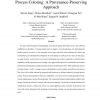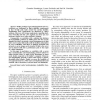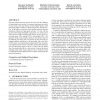1369 search results - page 207 / 274 » A Practical Implementation of the Timing Attack |
TPDS
2008
14 years 11 months ago
2008
To detect and investigate self-propagating worm attacks against networked servers, the following capabilities are desirable: (1) raising timely alerts to trigger a worm investigat...
113
click to vote
IEEEARES
2010
IEEE
14 years 9 months ago
2010
IEEE
Online auctions of governmental bonds and CO2 certificates are challenged by high availability requirements in face of high peak loads around the auction deadline. Traditionally, t...
144
click to vote
ISW
2010
Springer
14 years 9 months ago
2010
Springer
Computer malwares (e.g., botnets, rootkits, spware) are one of the most serious threats to all computers and networks. Most malwares conduct their malicious actions via hijacking t...
129
click to vote
CCS
2011
ACM
13 years 11 months ago
2011
ACM
Network intrusion detection systems are faced with the challenge of identifying diverse attacks, in extremely high speed networks. For this reason, they must operate at multi-Giga...
105
click to vote
CCS
2007
ACM
15 years 3 months ago
2007
ACM
Remotely-launched software exploits are a common way for attackers to intrude into vulnerable computer systems. As detection techniques improve, remote exploitation techniques are...




